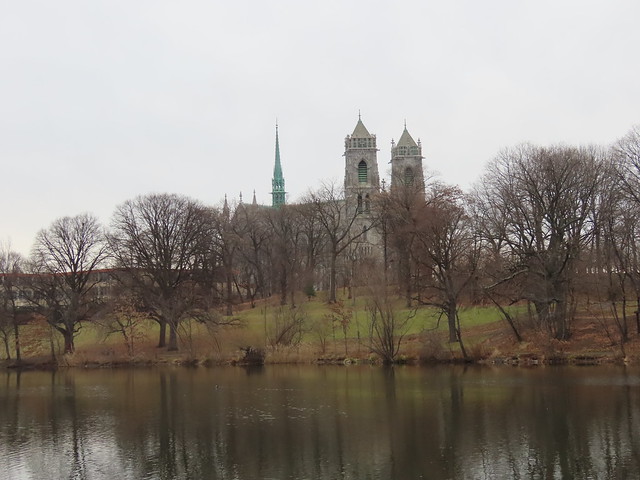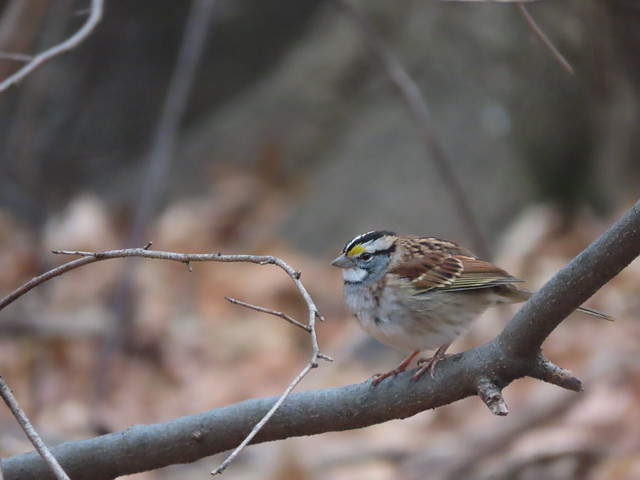I didn’t think I’d do it. But I did it anyway.
On December 27, 1921, R. F. Haulenbeek walked from the Forest Hill section of Newark to Bloomfield. He was back home for lunch, and spent an hour in the late afternoon in Branch Brook Park. The weather was seasonable: clouds giving way to sun, with an inch of new snow on the ground and temperatures from 29° to 38° F. This single-observer effort covering about 10 miles constituted the Newark Christmas Bird Count, the only CBC conducted in Essex County that year.

Haulenbeek recorded eight species for the day. The most abundant bird he encountered was the European starling; the species had arrived in our area only in 1903, but even then it was obviously on the path to success, as the day’s tally of some 100 birds suggested.

More surprising was the species that occupied second place on the list, the horned lark. Haulenbeek found some 50 larks on the farm fields along his morning’s route—fields, and larks, that are long gone today. The list was fleshed out by white-throated, song, and American tree sparrows, and one each of the sharp-shinned hawk, slate-colored junco, and blue jay. The total individuals counted came to about 167 birds.
On December 27, 2021, I walked from the southern edge of Branch Brook Park to Bloomfield. I was back home for lunch. The weather was seasonable: clouds and the occasional patch of sun, with very light snow at mid-day and temperatures from 28° to 37° F. I was joined for part of the morning by Alison; all told, I covered just shy of 10 miles on foot in the course of this mock CBC.

I recorded 24 species for the day. The most abundant bird was the Canada goose, with 60% of the approximately 1000 total birds at Clarks Pond; most appeared to be genuinely Canadian, migratory birds of the canadensis/interior type, but of course, most flocks also contained giant geese, the descendants of maxima/moffitti Canadasintroduced to the eastern US sixty years ago.

Unsurprisingly, the commonest passerine was the European starling, still going strong a century and a quarter after it colonized New Jersey. The small selection of native songbirds we found was dominated by white-throated sparrows; a minimum of 134 were seen and heard, most of them in a single active flock in Branch Brook Park.

The only other species to reach double digits were the mallard, at an impresive 330 individuals, and the feral pigeon, with a sloppily counted 249 on the day’s list; I suspect that Haulenbeek did not bother keeping track of the pigeons on the barn roofs along his 1921 route.
Several species on my list would have startled the observer 100 years ago. I most likely undercounted mourning doves, recording only 71—but early last century, this was apparently a rare bird in Essex County, and one very active birder, Louis S. Kohler of Bloomfield, recorded only ten individuals between 1905 and 1910, all of them migrants. Writing in that latter year, Kohler did not list the hooded merganser at all for Essex County; the four on one of the ponds in Branch Brook Park in 2021 were unsurprising, as were the 38 northern shovelers there, also a species Kohler did not encounter in our area. Our 17 ring-billed gulls struck me as a poor showing for that species, an abundant and familiar bird unnoticed by Kohler.

Among the highlights of our 2021 count were the two peregrine falcons that dashed through Branch Brook Park at the start of the walk; one was an adult and probably a female, the other too fast to age or sex. This dramatic bird is probably more common in New Jersey today than at any time in history. As expected, we were unable to replicate the experiences of birders a century ago, for whom another falcon, the American kestrel, was a common permanent resident in Essex County.
Three classic “southern” species were also unknown in our area a hundred years ago. In the first two decades of the twentieth century, northern cardinals were rare in New Jersey anywhere north of southern Union County. Their abundance today, even in suburban backyards, is the result of what John Bull called a “positively phenomenal” increase and northward range expansion beginning in the 1950s. Northern mockingbirds were only erratic visitors to Essex County until the late 1950s, when their populations, too, exploded and birds moved in to areas where they had formerly been rare. And as late as 1937, Witmer Stone considered the red-bellied woodpecker nothing more than “an accidental straggler,” even in southern New Jersey; as of 1955, Fables knew of only three records from the northern part of the state. Today, the red-bellied has nearly vanquished the downy as the most abundant picid in our area.
The story of the house finch in northern New Jersey is less clearly linked to global warming, though the survival and success of the birds released in New York in the early 1940s was certainly not entirely independent of changes in the climate. This early winter of 2021, it seems that there is still wild food available for house finches in our area—asters, goldenrod, poison ivy, liquidambar—and few are being seen yet in urban habitats. All the same, it is virtually impossible not to see or hear this bird almost anywhere in Bloomfield or Newark now, a species undreamed of by our co-hobbyists a hundred years ago.
A century to the day after R. F. Haulenbeek conducted his Christmas Bird Count, we saw approximately 13 times as many individual birds as he did. Even removing the waterfowl and feral pigeons, our count exceeded his by a good 500 bird—small consolation for encountering not a single one of the descendants of the horned larks on any of the parking lots and golf courses that have replaced the pastures and fields of an earlier landscape. But comparisons are always invidious. What matters—what counts—is enjoying a walk on a cold winter’s day.

